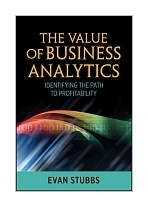|
||
podział tematyczny • wydawnictwa anglojęzyczne podział tematyczny Newsletter: • Zamów informacje o nowościach z wybranego tematu Informacje: • sposoby płatności i dostawy • kontakt • Cookies na stronie • Regulamin zakupów Napisz propresssp@gmail.com |
THE VALUE OF BUSINESS ANALYTICS: IDENTYFYING THE PATH TO PROFITABILITYSTUBBS E.wydawnictwo: WILEY , rok wydania 2011, wydanie Icena netto: Practical guidance for managers for getting projects started and presenting the results when the project's done This book provides an integrated framework for communicating the value of business analytics, focusing on a four-stage methodology to help with: (1) communicating the value proposition, (2) building the business case, (3) creating the execution plan, and (4) measuring the value.
Targeted toward the senior management team, this book explains what business analytics is and the value it can bring to your organization. EVAN STUBBS is the Regional Product Manager for Analytics at SAS Australia/New Zealand. A key champion for innovation and improvement, he advises organizations across multiple industry sectors and assists companies in achieving best practice in analytics. He has successfully applied analytics in a highly varied range of situations, from implementing an analytics-based policy planning toolkit within a large government department to creating the vision, market specifications, and demand forecasts for a concept car. Table of Contents Preface ix Acknowledgments xiii Chapter 1 Introduction and Background 1 The Power of Information 1 Modern-Day Magicians 3 The Secret of Success 5 Notes 7 Chapter 2 The Importance of Business Analytics 9 Introduction 9 Business Analytics: A Definition 10 Role of the Organization 13 Reasons behind Strategic Planning 17 Business Analytics and the Traditional View 25 Business Analytics and the External View 28 Business Analytics and the Internal View 35 Business Analytics and the Customer View 39 Fostering Innovation and Invention 44 Delivering Value through Renewable Return 46 Summary 51 Note 51 Chapter 3 The Challenges of Tactical Delivery 53 Introduction 53 Core Vocabulary 54 Common Team Structures 66 Roles and Responsibilities 68 Challenges of Applying Business Analytics 83 Finding the Path to Profitability 85 Selling the Value of Analytics 86 Meeting and Overcoming These Challenges 90 The Four-Step Framework 97 Note 97 Chapter 4 Defining the Value of Business Analytics 99 Introduction 99 Why You Need to Define the Value 100 Different Types of Value 103 Role of the Business Case 108 Identifying Tangible Value 115 Identifying Intangible Value 131 Simulating Business Cases 134 Practical Example: Reducing Churn in Telecommunications 140 Summary 143 Chapter 5 Communicating the Value Proposition 147 Introduction 147 Why You Need to Plan Your Communication Strategy 148 Need for a Communication Strategy 154 Awareness and Information Relevancy 158 Organizational and Societal Cultural Considerations 163 Conceptual Relevancy 172 The Path to Persuasion 178 Practical Example: A Forecasting Model for Planning 182 Summary 185 Note 187 Chapter 6 Creating the Execution Plan and Delivering Value 189 Introduction 189 Why You Need an Execution Plan 190 Role of the Execution Plan 194 Establishing Direction 195 Delivering to the Plan 215 Dealing with Resource Constraints 216 Planning for Success 220 Practical Example: Social Network Analysis 229 Summary 231 Chapter 7 Delivering the Measurement Framework 235 Introduction 235 Why a Measurement Framework Is Essential 236 Role of the Measurement Framework 241 Measuring What Is Important 247 Establishing a Measurement Framework 260 Delivering the Measurement Framework 263 Advanced Measurement Concepts 268 Practical Example: The Ongoing Growth of an Analytics Team 278 Summary 281 Chapter 8 Bringing It All Together 285 Introduction 285 Sarah’s Challenges 286 The Light-Bulb Moment 288 Transforming the Organization 292 Summary 296 Glossary 299 About the Author 317 Index 319 322 pages, Hardcover Księgarnia nie działa. Nie odpowiadamy na pytania i nie realizujemy zamówien. Do odwolania !. |


